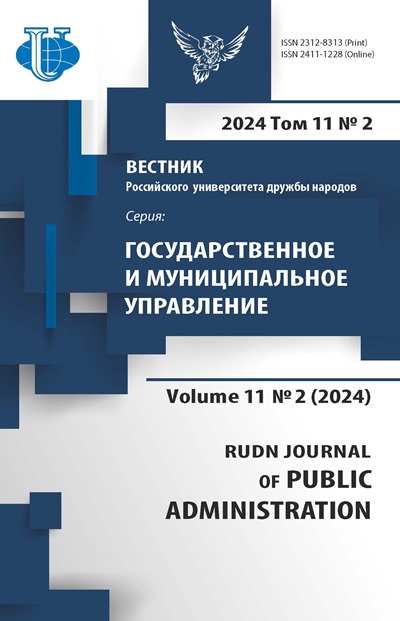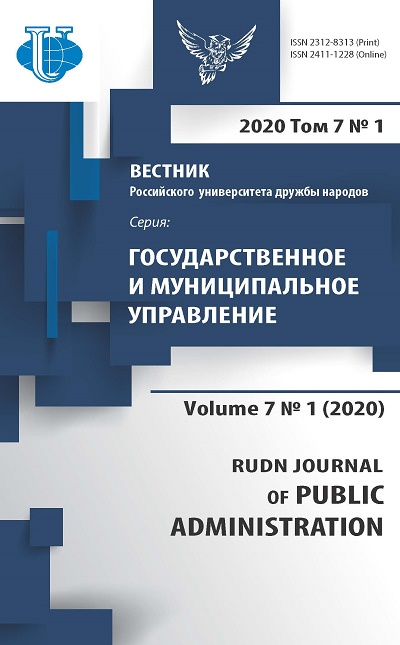Women’s Political Participation in Jordan
- Authors: Hawamdeh M.H.1, Al-Qteishat A.S.1
-
Affiliations:
- Peoples’ Friendship University of Russia (RUDN University)
- Issue: Vol 7, No 1 (2020)
- Pages: 83-88
- Section: INTERNATIONAL EXPERIENCE OF PUBLIC ADMINISTRATION
- URL: https://journals.rudn.ru/public-administration/article/view/23799
- DOI: https://doi.org/10.22363/2312-8313-2020-7-1-83-88
Cite item
Full Text
Abstract
Jordanian women’s participation in public policy dates back to 1950s. However, political activism came to a halt in the period between 1956 and 1992. In 1992, the new Political Parties Law granted women the right to participate in political parties. Since then, women became an active member of political parties, but their participation remained largely symbolic and not influential. Women did not seek to join parties. As a result, women are still largely unrepresented in the state. In addition, and the number of women involved in these parties remains low. There are a number of challenges that prevent women’s participation in political life in Jordan, such as social restrictions resulting from the traditional structure of Jordanian society. This article discusses the political participation of women in Jordan and addresses the most prominent challenges facing the political work of women in Jordan.
Full Text
One of the most important manifestations of democracy at the present time is the increasing participation of women in political life. Which western countries have gone a long way in comparison with many third world countries; the Kingdom of Jordan has ratified international treaties and conventions on the elimination of all forms of discrimination against women. Jordan has taken a number of steps to reform its legal framework in order to encourage increased women’s inclusion in politics and increase their overall political participation. Ratify international conventions whose principles support gender equality (i.e. CEDAW, ISECR, and ICCPR). Women’s representation in political life Since 1921, Jordanian women have played different roles in public life, especially in charitable societies. The Jordanian Women’s Union was founded in the early 1940s. After that, the number of women’s charities with multiple goals increased, and since 1950 women’s participation in political parties began [1]. Since 1955, Jordanian women obtained the right to vote, but have not been obtained the right to run for election and have not exercised their full right to run for election until 1974 [2]. The actual change in political and parliamentary life was with the 1989 elections. For the first time, the Jordanian woman participated as a candidate, but they did not get any seat in the house of Parliament in 1989. In 1993, Toujan Faisal became the first woman elected to Jordan’s lower house of parliament. In reading the presence of Jordanian women in the House of parliament since the return of democratic life in 1989 until the 2016 elections, it is possible to observe the following: In 1989, women participated in the elections in which 12 women were nominated, but no women won. In 1993 three women were nominated and one woman won. In 1997, seventeen women were nominated but no female candidates were elected, in 2003 elections, 54 women were nominated. During the elections, the quota system was introduced, which allowed six women to enter the House of parliament, but not outside the quota system*, but with the help of the quota, in 2007, 199 women were nominated and six women won on the basis of the quota system, while one candidate won free competition, In the 2010 elections, women won 13 more seats out of 78, in the 2013 elections, women won 18 out of 150 seats , in the 2016 elections, women won 20 out of 130 seats, the highest representation of women in the Jordanian parliament [3]. As for the participation of Jordanian women in the government, ministerial posts continued to be reserved for men until 1980, in that year, the first woman was appointed of the ministerial post, the Ministry of Social Development. Only one ministerial portfolio was obtained in each cabinet reshuffle until 2009, when four women held ministerial posts in Nader Dahabi’s government [4]. As for the participation of women in the political parties, it is still very low despite the fact that the Parties Law gave women the right to participate in the establishment and affiliation of parties. However, the statistics indicate that the participation rate of women in the constituent bodies of parties does not exceed 10%. It is noted that most of the licensed political parties in Jordan do not address the issue of women in a serious, effective and independent manner in their programs. The Jordanian State recognizes the importance of women’s presence and participation in political life in the belief that this is an essential part of the process of development in general and political development in particular. Jordan is one of the first countries to recognize the Universal Declaration of Human Rights, which gave every man or woman the right of freedom opinion and expression. Jordan is one of the first signatories to the International Covenant on Economics, Social and Cultural Rights and the Covenant on Civil and Political Rights, As well as the Convention on the Elimination of All Forms of Discrimination against Women, which constituted a powerful level for the growing rights of Jordanian women and a step towards enabling them to participate in political life, in addition to empowering women in the parties and electoral law, and more of a civil and political rights [5]. Jordan ranks 11th among in the Middle East countries in terms of women’s representation in lower or single houses of Parliament [3] (table 1, table 2). Table 1 Women’s regional representation in lower or unicameral houses of parliament (%) Rank Country Chamber (Lower House/Unicameral) Women MP’s 1 Tunisia Majlis Nawwab ash-sha’ab 31.3% 2 Sudan Majlis Watani 30.5% 3 Isreal Knesset 27.5% 4 Algeria Al-Majlis Al-Chaabi Al-Watani 25.8% 5 Iraq Council of Representativesof 25.3% 6 Mauritania Majlis Watai Itihadi 25.2% 7 United Arab Emirates Al Jamiya-Al-Watani Itihadi 22.5% 8 Morocco Majliss-annouwab 20.5% 9 Saudi Arabia Majlis Ash-Shura 19.9% 10 Libya Majlis Al-Nuwaab 16.0% 11 Jordan Majlis Al-Nuwaab 15.4% 12 Egypt Majlis Al-Nuwaab 14.9% 13 Syrian Arab republic Majlis Al-Chaab 13.2% 14 Qatar Majlis Al-Shura 9.8% 15 Bahrain Majlis Al-Nuwaab 7.5% 16 Lebanon Majlis Al-Nuwaab 3.1% 17 Kuwait Majlis Al-Nuwaab 3.1% 18 Oman Majlis Ash-Shura 1.2% 19 Yemen Majlis Al-Nuwaab 0% Source: IPU Open Data (2018) https://data.ipu.org/. Table 2 Women’s Representation in Jordan’s House of Representatives (1989-2016) House of Representatives Year of election Total Number of MPs Number Of Female MPs Women’s Representation (%) 11th 1989 80 0 0% 12th 1993 80 1 13% 13th 1997 80 0 0% 14th 2003 110 6 5.4% 15th 2007 110 7 6.4% 16th 2010 120 13 10.8% 17th 2013 150 18 12% 18th 2016 130 20 15.4% Source: IPU Election Archives for Jordan: Majlis Al-Nuwaab (House of Representaives). Remaining obstacles to women’s political participation It is possible to say that there are a number of obstacles and challenges that prevent the participation of Jordanian women in political life. The most prominent of these are: the dominance of patriarchal culture in the Jordanian society, based on the social and economic culture; the lack of experience of Jordanian women in the political field; This field, Weak civil society institutions in Jordan, which affects its role in activating and enhancing the political participation of male and female citizens as modern units that can be alternative units to traditional units, where political parties and other civil society organizations suffer from weakness and instability, which negatively affect the advancement of women’s role in political participation. In addition to, weak political awareness of the Jordanian society members in general, and women in particular about the importance of women political participation, Economic dependency of women on men due to their low participation in economic activity and men’s ownership of scarce resources. Conclusion Despite the quotas for female inclusion in national and municipal bodies, political participation remains limited. In addition, women represent only one-sixth of the seats in Jordanian parliament. Although support for improvement does exist, there are many obstacles that effect the participation of women on political life in return. The political role of Jordanian women in parliament is still limited, although Jordanian women make up about 52 percent of the electorate. In terms of female representation in parliament, Jordan lags behind other countries generally, with a ranking of 13 in the Arab world and 141st globally. In the last elections of 2016, five women managed to reach the parliament directly by winning elections, while 15 women succeeded to reach it through the quota system, bringing the total number of women in the 130-member house to 20. Which is the highest percentage in the history of women’s political participation.
About the authors
Mazen Hussien Faleh Hawamdeh
Peoples’ Friendship University of Russia (RUDN University)
Author for correspondence.
Email: mazen_1616@yahoo.com
Assistant of the Department of Public Administration, Postgraduate Student of the Department of Comparative Politics
Miklukho-Maklaya str., 6, Moscow, Russian Federation 117198Ahmad Saher Ahmad Al-Qteishat
Peoples’ Friendship University of Russia (RUDN University)
Email: ahmad_qteishat@hotmail.com
Assistant of the Department of Public Administration, Postgraduate Student of the Department of Comparative Politics
Miklukho-Maklaya str., 6, Moscow, Russian Federation 117198References
- Amal Abu Jiries. The Reality of Women’s Political Participation in Jordan. Netherlands Institute for Multiparty Democracy. 27.08.2019. URL: https://nimd.org/the-reality-of-womens-political-participation-in-jordan/. Accessed: 25.11.2019.
- Abeer Bashier Dababneh. Jordanian Women’s Political Participation: Legislative Status and Structural Challenges. European Journal of Social Sciences. 2012. 27 (2): 213-221.
- The Jordanian National Commission for Women, Women’s Political Participation in Jordan. MENA - OECD Governance Programme. 2018. 96 p. URL: http://www.oecd.org/mena/governance/womens-political-participation-in-jordan.pdf. Accessed: 25.11.2019.
- Fatima Atiyat. Jordanian Women Participation in the Parliamentary Elections of 2016: Field Study in Albalqa Governorate. International Journal of Humanities and Social Science. March 2017; 7 (3): 109-122.
- Ministry of Political and Parliamentary Affairs (Jordan). URL: http://www.moppa.gov.jo/ Default.aspx. Accessed: 25.11.2019 (In Arab.).
















